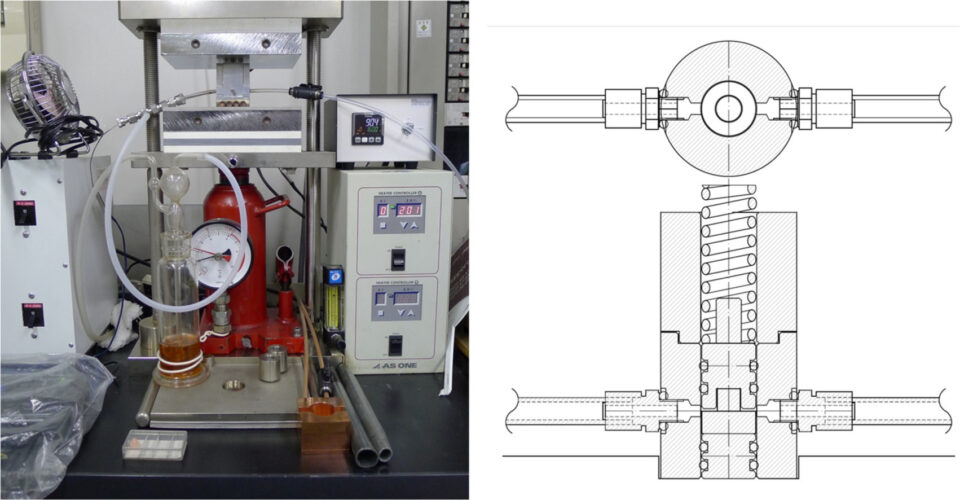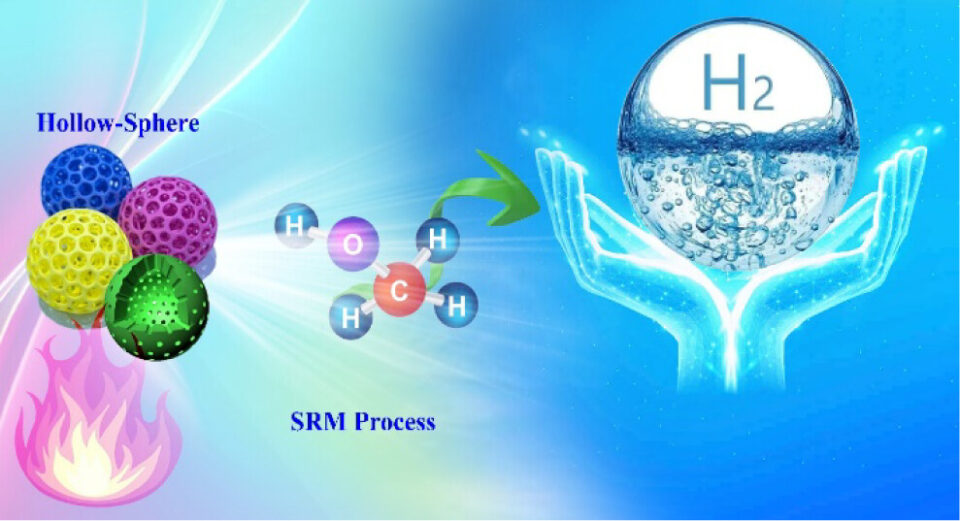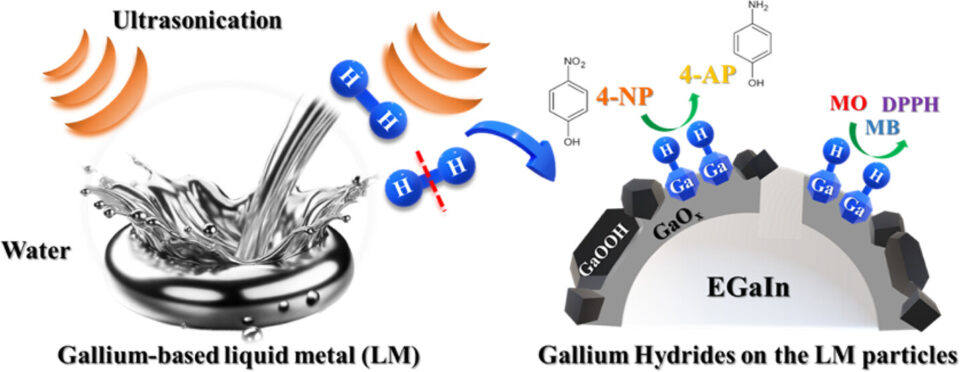名前を赤で表記しているメンバーは当研究室の学生・院生、青で表記しているメンバーは当研究室の教員です。
原著論文
- Shell Thickness Dependent Interfacial Charge Carrier Dynamics and Photocatalytic CO2 Reduction over CdS/UiO-66-NH2 Core/Shell Nanorods
Kai-An Tsai, Yu-Chen Wei, Yu-Chieh Li, Kai-Chun Chou, Show-Heng Liu, Jui-Cheng Chang, Chun-Wei Kung, Shih-Wen Tseng, Tetsu Yonezawa, Shen-Kuei Chiu, Jin Zhang, Ying-Chih Pu
ACS Applied Nano Materials, in press.【ACS】(IF=5.1)
【国際共同研究】 - Shu-Han Juang, Chung-Lun Yu, Subramanian Sakthinathan, Tetsu Yonezawa, Ching-Lung Chen, Te-Wei Chiu, Naratip Vittayakorn
Preparation and Studies of ZnFe2O4–CeO2 Nanopowder via Self Combustion Glycine Nitrate Process for Methanol Steam Reforming Hydrogen Production
ACS Sustainable Resource Management, 2(8), 1416-1424 (2025). 【ACS】
DOI: 10.1021/acssusresmgt.5c00140 (Published (web) 28 July 2025)
【国際共同研究】

Abstract: As fossil fuels have finite resources and environmental drawbacks, there’s a growing interest in cleaner, renewable energy. Hydrogen (H2) is seen as a promising alternative to petroleum due to its non-toxic, clean combustion that only produces water and avoids carbon dioxide emissions. In this study, different ratios of ZnFe2O4–CeO2 nanopowder were synthesized via the glycine nitrate process (GNP). The ZnFe2O4–CeO2 nanopowder catalyst was prepared by GNP, which was immensely porous and had a cotton-like structure. Moreover, the glycine nitrate process, which is a synthesis technology, can offer the advantages of low cost, simplicity, and speed and create a porous structure for the catalyst. The BET measurement revealed that the specific surface area of the as-combusted ZnFe2O4–CeO2 nanopowder varied from 8.48 m2/g to 19.82 m2/g. Hydrogen production through the SRM process was monitored by using a gas chromatograph equipped with a thermal conductivity detector. The 20ZnFe2O4–80CeO2 powder had the highest H2 production without activation, reaching 7566.08 mL STP min–1 g-cat–1 at a reaction temperature of 550 °C achieved at an N2 flow rate of 30 sccm. This study indicates that the glycine nitrate process imparts a porous structure to the catalyst, thereby increasing hydrogen production. Moreover, suitable incorporation of CeO2 could improve the catalytic performance in the SRM process on hydrogen. Therefore, ZnFe2O4–CeO2 nanopowders may have significant economic prospects.
- Durai Govindarajan, Abdulkadeem Sanni, Wanwisa Limphirat, Kamalan Kirubaharan, Govindhasamy Murugadoss, Ahmad Azmin Mohamad, Tetsu Yonezawa, Soorathep Kheawhom Atomic-level synergy in multi-valent metal oxide-graphene composites for ultra-high-performance supercapacitors
Journal of Alloys and Compounds, 1039, 183022 (2025).【Elsevier】(IF = 6.3)
DOI: 10.1016/j.jallcom.2025.183022 (Published (web) 13 August 2025)
【国際共同研究】
Abstract: Closing the gap between the high energy of batteries and the fast power delivery of supercapacitors requires electrodes that couple multielectron redox kinetics with enduring structural integrity. Here we report a ternary metal-oxide/graphene hybrid, Co3O4-Fe2O3-NiO nanoclusters conformally anchored on graphene sheets (CFN@GSs), produced in a single low-temperature hydrothermal step. The CFN@GSs electrode delivers 1.04 kF g−1 at 1 A g−1 and retains 92 % of its capacitance after 5000 cycles. Operando X-ray absorption spectroscopy confirms the reversible Co2+/Co3+ transitions within the CFN@GSs electrode. These multivalent redox processes, together with the highly conductive graphene scaffold, create efficient electron pathways and buffer structural strain, collectively contributing to lower charge-transfer resistance and enhanced rate capability. As the positive electrode in an asymmetric coin-cell device with activated carbon, CFN@GSs delivers 107 Wh kg−1 at 1.35 kW kg−1 and sustains 83 Wh kg−1 at 6 kW kg−1. The scalable synthesis, high specific energy, and robust cycling stability highlight CFN@GSs as a viable platform for high-power portable devices and short-term grid buffering.
- Zhen-Yuan Lan, Dhanapal Vasu, Yung-Chieh Liu, Chung-Lun Yu, Te-Wei Chiu, Tetsu Yonezawa, Hongbing Jia
Highly efficient catalytic activity of MXene Nanosheet supported on CuFeO2 nanoparticles applied on hydrogen evolution
Ceramics International, 51(16) B, 22592-22599 (2025).【Elsevier】(IF=5.6)
DOI: 10.1016/j.ceramint.2024.11.181(Published (web) 13 November 2024)
【国際共同研究】
Abstract: The development of efficient and clean renewable energy to replace fossil fuels has been a prominent topic in recent years, with HER in the field of renewable energy widely regarded as a promising avenue. The HER involves the adsorption and desorption of hydrogen ions, making the electron transfer rate particularly crucial. This study employed a novel chemical solution route under an ambient atmosphere to prepare highly crystalline hexagonal ferromagnetic material CuFeO2 nanoparticles. By incorporating the Nanosheet material MXene, forthputting its unique strong interlayer Van Der Waals forces, CuFeO2 is embedded within the layers of MXene. Compounding CuFeO2 with MXene increases the active sites of the material, enhancing electron transfer rates and reducing the required potential for HER. The electrochemical impedance spectroscopy results demonstrated a significant reduction in resistance upon the addition of MXene. The best HER performance was observed in CFO-300mg MX, exhibiting the lowest overpotential of −0.5 V vs. RHE and a Tafel slope of 147 mV dec−1.
- Mohammad Etesami, Poobodin Mano, Supawadee Namuangruk, Ramin Khezri, Mohan Gopalakrishnan, Wanwisa Limphirat, Tetsu Yonezawa, Shiva Rezaei Motlagh, Anongnat Somwangthanaroj, Soorathep Kheawhom
Solvent-free synthesis of FeCo alloy nanoparticle-embedded nitrogen-doped carbon nanotubes for oxygen reduction in zinc-air batteries
Journal of Hydrogen Energy, 153, 150289 (2025).【Elsevier】(IF=8.3)
DOI: 10.1016/j.ijhydene.2025.150289(Published (web) 30 July 2025)
【国際共同研究】
Abstract: The development of cost-effective, durable, and high-performance electrocatalysts for oxygen reduction reaction (ORR) is crucial for advancing renewable energy technologies. Here, we report a facile solvent-free synthesis approach, which employs dicyandiamide (DCDA) as both the carbon and nitrogen source, resulting in highly active FeCo alloy nanoparticle-embedded nitrogen-doped carbon nanotubes (FeCo-CNTs) as ORR electrocatalysts. Following acid treatment, the FeCo-CNT-W catalyst exhibited a significantly enhanced surface area of 207.06 m2 g−1 (compared to 23.25 m2 g−1 pre-treatment). During treatment, unfavorable species were removed, creating an optimized catalytic structure. The catalyst demonstrated great ORR performance through a four-electron transfer pathway with minimal hydrogen peroxide formation, surpassing the commercial Pt/C catalysts in both activity and durability. When implemented as a cathode material in a zinc-air battery (ZAB), the FeCo-CNT-W maintained stable performance for 495 h under charge-discharge cycling at 5 mA cm−2 (compared to 85 h for Pt/C + RuO2) while achieving a superior power density of 70.2 mW cm−2 at 79.5 mA cm−2. This work presents a sustainable and scalable approach for developing high-performance non-precious metal electrocatalysts for next-generation energy conversion systems.
- Hung-Chang Cheng, Dhanapal Vasu, Hsin-Yu Lin, Zhen-Yuan Lan, Leggins Abraham, Tetsu Yonezawa, Te-Wei Chiu
Sustainable Energy Generation through Engineered Copper Molybdate: A Ternary Metal Oxide Catalyst for Efficient Oxygen Evolution in Alkaline Environments
Fuel, 401, 135906 (2025).【Elsevier】(IF = 6.7)
DOI: 10.1016/j.fuel.2025.135906 (Published (web) 4 June 2025)
【国際共同研究】
Abstract: The world is currently facing an energy shortage, and renewable hydrogen technology is regarded as a key alternative to fossil fuels. Among these technologies, water splitting processes, such as oxygen evolution reaction (OER) and hydrogen evolution reaction (HER), have attracted significant attention for their environmentally friendly nature. This study focuses on the synthesis and application of copper molybdate (Cu3Mo2O9) based ternary metal oxides (TMOs), which exhibits an orthorhombic crystal structure, variable oxidation states, and excellent redox properties, making it highly promising for applications in electrocatalysis and energy storage. Using the hydrothermal method, the reaction solution pH was adjusted to identify the sample with optimal crystallinity and structural characteristics. Experimental results show that Cu3Mo2O9 nanoparticles with superior crystallinity was successfully synthesized at pH 11. The optimized pH electrocatalyst exhibits better OER with an overpotential of 170 mV at a current density of 10 mA cm−2 and Tafel value of 153 mV/dec. TMOs have high specific capacitance and excellent stability, highlighting its potential as an energy material.
- Lyn Marie de Juan Corpuz, Michael Franco, Wei Jian Sim, Gil Nonato Santos, Tetsu Yonezawa, Ryan D. Corpuz
Spider-Egg-Like Structured α-MnO2 as an Efficient Cathode Material for Aqueous Rechargeable Zinc-Ion Batteries
Journal of the Chinese Chemical Society, in press.【Wiley】(IF = 1.6)
DOI: 10.1002/jccs.70045 (Published (web) 15 June 2025)
【国際共同研究】
Abstract: This study reports the direct hydrothermal growth of α-MnO₂ on carbon fiber textile without the use of polymeric binders, yielding a unique “spider-egg-like” morphology. Unlike conventional MnO₂-based cathodes, where active materials require binders and conductive additives, this approach ensures strong adhesion to the substrate while maintaining high conductivity and mechanical stability. SEM revealed spherical MnO₂ structures entangled within a nanowire network, creating a porous, interconnected architecture that enhances ion diffusion and charge transfer. XRD confirmed the formation of crystalline α-MnO₂, while EDS and XPS validated its elemental composition and mixed-valence states, highlighting its redox activity. Electrochemical characterization demonstrated its potential as a cathode for ARZIBs, delivering an initial capacity of 367 mAh/g. The composite maintained stable discharge capacities of 218, 120, 102, and 79 mAh/g at 0.1C, 0.3C, 0.5C, and 1C, respectively, with 88.94% capacity retention over 350 cycles. Its long-term stability and nearly 100% Coulombic efficiency confirm the robustness of the direct-growth architecture in facilitating reversible Zn2+ intercalation. The binder-free synthesis method presents a scalable and eco-friendly alternative to conventional electrode fabrication, reducing processing steps while improving electrochemical performance. This study introduces a novel approach to designing MnO₂ cathodes, offering a high-performance, mechanically stable, and conductive material for next-generation ARZIBs.
- Tetsu Yonezawa and Hiroki Tsukamoto
Prototype of Fixtures for Pressure Sintering Using a Commercial Hot Press and Die Shear Test Using a Small-Scale Tensile Extrusion Testing Machine
Next Research, 2(2), 100278 (2025).【Elsevier】
DOI: 10.1016/j.nexres.2025.100278 (Published (web) 19 March 2025)
【研究室内研究】

Abstract: This study explores the use of copper nanoparticles and microparticles as alternatives to silver in low-temperature sintered bonding materials for high-performance semiconductors. Despite copper’s advantages in cost and ion-migration resistance, challenges remain in crystal structure and oxidation. To advance this research, we developed heating and pressing bonding fixtures, as well as shear strength measurement fixtures, suitable for university laboratory settings. This paper presents the design and application of these tools, which are expected to significantly contribute to the advancement of bonding material research. By providing accessible equipment for academic research, this work aims to accelerate the development of copper-based sintered bonding materials for next-generation power electronics.
- Yung-Chieh Liu, Dhanapal Vasu, Zhen-Yuan Lan, Kuan-Jun Ke, Bo-Han Chen, Wei Jian Sim, Te-Wei Chiu, Liangdong Fan, and Tetsu Yonezawa
Resourceful Hydrogen Generation through Methanol Steam Reforming Using Rare-Earth Metal Oxide-Modified Delafossite 3D Hollow Spheres
Langmuir, 41(6), 4165-4175 (2025). 【ACS】(IF = 3.7)
DOI: 10.1021/acs.langmuir.4c04727 (Published (web) 5 February 2025)
【国際共同研究】
 Abstract: The world is moving toward the goal of achieving net-zero carbon emissions by 2050, and hydrogen energy is considered an excellent alternative to nonrenewable energy sources. In this regard, developing a catalyst that is both economically valuable and exhibits efficient hydrogen production is a primary task at the current stage. This study utilized a hydrothermal synthesis method to prepare a nanosized 3-dimensional (3D) hollow sphere of CuCrO2–CeO2 for use in the Steam Reforming of Methanol (SRM) process. The characteristics and morphology of prepared CuCrO2–CeO2 hollow sphere were characterized by using various techniques such as XRD, FESEM, HRTEM, FTIR, Raman, etc. The CuCrO2–CeO2 hollow spheres with a 1:2 ratio exhibited the highest hydrogen production efficiency at 550 °C, yielding 6372.73 mL STP min–1 g cat–1 per gram of catalyst. Furthermore, the incorporation of CeO2 not only enhanced the hydrogen production rate of CuCrO2 but also extended the applicability of CuCrO2 nanoparticles to a wider temperature range. The unique 3D hollow sphere structure of the catalyst offers numerous advantages such as low cost, multiple catalytic reaction sites, and easy preparation. Therefore, CuCrO2–CeO2 hollow spheres hold potential for commercial development.
Abstract: The world is moving toward the goal of achieving net-zero carbon emissions by 2050, and hydrogen energy is considered an excellent alternative to nonrenewable energy sources. In this regard, developing a catalyst that is both economically valuable and exhibits efficient hydrogen production is a primary task at the current stage. This study utilized a hydrothermal synthesis method to prepare a nanosized 3-dimensional (3D) hollow sphere of CuCrO2–CeO2 for use in the Steam Reforming of Methanol (SRM) process. The characteristics and morphology of prepared CuCrO2–CeO2 hollow sphere were characterized by using various techniques such as XRD, FESEM, HRTEM, FTIR, Raman, etc. The CuCrO2–CeO2 hollow spheres with a 1:2 ratio exhibited the highest hydrogen production efficiency at 550 °C, yielding 6372.73 mL STP min–1 g cat–1 per gram of catalyst. Furthermore, the incorporation of CeO2 not only enhanced the hydrogen production rate of CuCrO2 but also extended the applicability of CuCrO2 nanoparticles to a wider temperature range. The unique 3D hollow sphere structure of the catalyst offers numerous advantages such as low cost, multiple catalytic reaction sites, and easy preparation. Therefore, CuCrO2–CeO2 hollow spheres hold potential for commercial development.
- Nichayanan Manyuan, Naoya Tanimoto, Kousuke Ueda, Ken Yamamoto, Tomoharu Tokunaga, Masaki Nishio, Tetsu Yonezawa, Hideya Kawasaki
“Ultrasonically Activated Liquid Metal Catalysts in Water for Enhanced Hydrogenation Efficiency”
ACS Applied Materials & Interfaces, 17(4), 6414-6427 (2025).【ACS】(IF = 8.5)
DOI: 10.1021/acsami.4c19936 (Published (web) 17 January 2025)
【国内共同研究】

Abstract: Hydride (H–) species on oxides have been extensively studied over the past few decades because of their critical role in various catalytic processes. Their syntheses require high temperatures and the presence of hydrogen, which involves complex equipment, high energy costs, and strict safety protocols. Hydride species tend to decompose in the presence of atmospheric oxygen and water, which reduces their catalytic activities. These challenges highlight the need for further research to improve the stability and efficiency of catalytic processes and develop safer and cost-effective synthesis methods. This paper introduces an ultrasonic fabrication method for gallium hydride species on liquid metal (LM) nanoparticles (Ga–H@LM NPs) in water and describes the evaluation of their catalytic properties. The Ga–H@LM NPs were synthesized by dispersing liquid metals of eutectic gallium–indium in water using a two-step ultrasonication process in an ice bath. The presence of Ga–H species was confirmed by Fourier-transform infrared spectroscopy. The Ga–H@LM NPs demonstrated the rapid catalytic hydrogenation of 4-nitrophenol and reductive degradation of azo dyes within minutes without the need for external reducing agents like NaBH4. The proposed mechanism involves high-energy ultrasonic cavitation at the interface between LM NPs and water, which promotes the formation of H2 from water and its activation to form Ga–H on particles surface during ultrasonication. This study has significant implications for advancing the field of catalysis because it provides a novel and efficient catalytic method for the synthesis of stable hydride species on gallium oxides.
- Mohan Gopalakrishnan, Myo Thandar Hlaing, Thirumoorthy Kulandaivel, Wathanyu Kao-ian, Mohammad Etesami, Wei-Ren Liu, Mai Thanh Nguyen, Tetsu Yonezawa, Wanwisa Limphirat, Soorathep Kheawhom
“Tunable N-doped Carbon Dots/SnO2 Interface as a Stable Artificial Solid Electrolyte Interphase for High-Performance Aqueous Zinc-Ion Batteries”
Journal of Alloys and Compounds, 1013, 178521 (2025). (pp.11)【Elsevier】(IF = 5.8)
DOI: 10.1016/j.jallcom.2025.178521 (Published (web) 8 January 2025)
【国際共同研究】
Abstract: Poor stability of zinc (Zn) anode hinders the use of aqueous zinc-ion batteries (AZIBs) for large-scale energy storage. Here, we report an effective artificial solid electrolyte interphase (ASEI) using N-doped carbon dots (CDs) and SnO2 to stabilize Zn anodes. By optimizing the CDs/SnO2 ratio, we can synthesize porous composites to construct “bayberry” and flower-like morphologies. The N-doped CDs/SnO2 anode creates surface dipoles and changes in charge distribution, allowing Zn ions to move to nitrogen functionalized sites with reduced adsorption barriers. Furthermore, hydroxyl oxygen boosts the surface’s hydrophilicity, resulting in stronger adhesion to the Zn anode and better ion accessibility. This generates dense nucleation sites for uniform Zn deposition. The CDs/SnO2@Zn electrode achieves a low nucleation potential of 47 mV and maintains 99.6% coulombic efficiency (CE) over 1000 cycles at 2 mA cm-2. In the symmetrical cells, the modified Zn anode exhibits stable cycling for 1,200 h at 1 mAh cm-2. A full cell with CDs/SnO2@Zn anode and MnO2 cathode retains 96.6% capacity after 800 h. This study introduces a promising strategy for stabilizing Zn anodes and offers valuable insights for designing dendrite-free electrodes in next-generation AZIBs.
